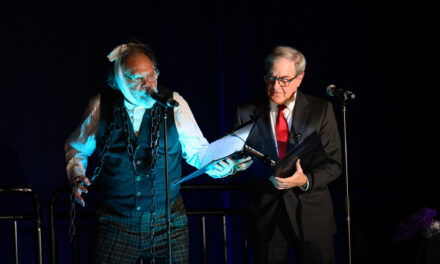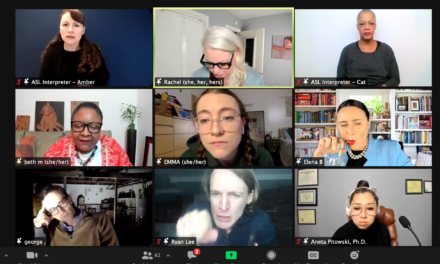Zac Campbell-Hoogendyk in Ossietzky: A Peace Play. Photo: Brian Owens
VOTE FOR THE ARTS-LOUISVILLE THEATRE AWARDS HERE!
Ossietsky: A Peace Play
By Zac Campell-Hoogendyk
Directed by Megan Massie Ware
A review by Keith Waits
Entire contents are copyright © 2022 by Keith Waits. All rights reserved.
It is not often we are gifted with a World Premiere in Louisville, especially by a locally-based writer and actor.
The words “Nazi concentration camp” are synonymous with the Holocaust and the attempted extermination of European Jews, but Carl Von Ossietsky was not Jewish. He was imprisoned by the Nazi regime because he was a journalist who worked to expose the clandestine re-armament of Germany that directly violated the Treaty of Versailles. Imprisoned before the camps were built, released, but then placed in a concentration camp in 1933 after continuing to publish articles about the increasing Nazi stranglehold on German society, he was awarded the 1935 Nobel Peace Prize while still imprisoned at the Esterwegen camp.
How is that possible? Although this story is largely forgotten, at the time Ossietzky was a high profile journalist in Berlin whose opposition voice had impact even after he was locked away. An international effort was organized to nominate him to the Nobel committee by friends and colleagues. It was hoped that such a recognition would elevate his work and obtain his release. Not surprisingly, Hitler was unmoved.
As a playwright, Zac Campbell-Hoogendyk is clearly drawn to the parallels he finds between this time period and the modern day. As he notes in the program notes, such comparisons have become cliche – we’ve been hearing them for the last twenty years – but his argument here is particularly compelling. The idea is reinforced by the fact that his early 20th century characters speak in something resembling 21st century voices. The choice feels sound for connecting us more forcefully to these characters, reducing the distance of time and place, and never feels false.
But Campbell-Hoogendyk’s thesis is strengthened by the depth of the diagram he draws. Ossietzky was a soldier in World War I, so his journey begins with a gun and the killing of others, and later he argues the futility of his campaign for peace by recognizing how effective a tool it is, “…and if you want to own a gun just point one and you will have it!” It would seen nearly impossible to hear that line and not think of the contentious , ongoing debate about gun laws in the United States. I think that is the playwright’s intention but he is also examining the root of militarism in a troubled society. However didactic the play becomes, it works so well because the lessons look deeper than the obvious.
It is also natural because Ossietzky was an activist; he spoke in those terms. He was brought to that frame of mind, “radicalized”, if you will, by his wife, Maud (Mehru Hassan), who had worked passionately in the German suffrage campaign. His best friend, Kurt Tucholsky (Edgar Miguel Sanchez) is a pacifist who survived the Eastern Front of WWI by never carrying a gun, and Ossietzky seems formed from new clay by these two powerful personalities.
Ossietzky: A Peace Play is a long, thoughtful piece but it is never a slog. Its is dialogue heavy but carries it’s weight well because of Campbell-Hoogendyk’s careful attention to structure. He frames the story with an interview with Hilde Hiller (Tessa McShane), who has been granted permission by the Commander at Esterwegen camp (Tony Milder). She has come to gather information to make the case to the Nobel committee and, after some difficulty, Ossietzky’s life unfolds through flashbacks.
But it also works so well because of the force of the playing. The playwright does double duty here as the title character and it is an engrossing, mercurial turn. Wearing the uniform of the concentration camp he must shift into the character at various points over a 20 year span. It is a fluid performance, accomplished through nuanced shifts in vocal timber and physical posture and, needless to say, a unique depth iof understanding of the character.
Under Megan Massie Ware’s sure hand as director, Edgar Miguel Sanchez as Kurt is a bolt of lightening onstage, charismatic almost to a fault but also a catalyst for the other members of the cast. You can almost see the electricity between them. As Maude, Mehru Hassan is tasked with an arguably greater transition than Campbell-Hoogendyk’s Ossietsky. She begins as a firebrand who changes his life through the passion of her convictions and bold activism, but eventually succumbs to depression and alcoholism as her husband’s commitment to peace exceed her own. Hassan is magnetic in her earlier scenes, making full sense of the love at first sight aspect and making it easy to picture her rallying German suffragists. Later, her lustre has dimmed to allow for the darker currents to show.
Tessa McShane and Tony Milder are very good in the camp scenes, although it is here that the text brushes up against cliche. Overplaying when wearing a swastika on your arm is an easy trap, but Milder is charmingly confident in his generosity as “host” for Hiller and restrained until very late in the action. Charm is also crucial for McShane as she works to convince two opposing men. These two are not the most developed characters yet the emphasis on superficial manners in the circumstance builds tension, and when Milder’s Hauptscharfurer Sorge feels the need to demonstrate his position of power it effectively reminds us of the insecurity at work in any dictator. Yet the scene is the one moment where the performances felt wrong to me, as Hiller’s strength and resolve is gone in an instant, and the action is archly melodramatic for several moments. I would have wished for a better transition here.
All of that action plays out Campbell-Hoogendyk’s sombre set design, which provides a functional space with just enough detail for the camp and just enough generic to read as an apartment, a beer hall, a cafe, or an editor’s office. Best of all it surrounds the audience with a wooden fence topped with barbed wire. The lighting by LIndsay Krupski activates all of the space and makes good visceral effect behind the set suggesting several large-scale scenes of battle and fire. Donna Lawrence-Downs costumes the characters in appropriate period and I particularly liked the way that Ossietzky’s camp garb was accurately shabby but never distracted in the flashbacks.
To reinforce the context and heavily-researched foundation of the text, a projection of historical footage and quotations by Kasey Campbell-Hoogendyk grounds and expands the narrative, and is ably supported by Alex Cooper’s sound design. And none of it felt familiar; no small accomplishment with this time period.
After several years of fascism in America being portrayed through absurd cartoons (Obama with a Hitler mustache – really?!?) or simple-minded quotations, it is easy to understand Campbell-Hoogendyk’s fervent desire to share a story that explores the more meaningful parallels in such detail. While we are preoccupied with smearing the opposition leader as a Neo Hitler, Ossietzky: A Peace Play illustrates how the slide into such extreme political and social change happens gradually, while only a few voices warn the rest of us that the sky is indeed falling.
Featuring Zac Campbell-Hoogendyk, Mehru Hassan, Tessa McShane, Tony Milder, Edgar Miguel Sanchez
Ossietsky: A Peace Play
January 20, 21, 22, 26, 27, 28, & 29 @ 7:30 pm
January 22, 23, 29, & 30 @ 2:00 pm
For tickets: Kentuckyperformingarts.org
Kentucky Performing Arts
501 West Main Street
Louisville, KY 40202
Keith Waits is a native of Louisville who works at Louisville Visual Art during the days, including being the host of LVA’s Artebella On The Radio on WXOX 97.1 FM / ARTxFM.com, but spends most of his evenings indulging his taste for theatre, music and visual arts. His work has appeared in LEO Weekly, Pure Uncut Candy, TheatreLouisville, and Louisville Mojo. He is now Managing Editor for Arts-Louisville.com.





